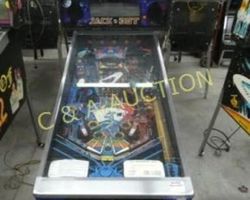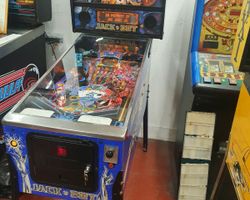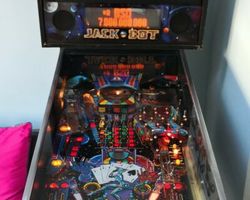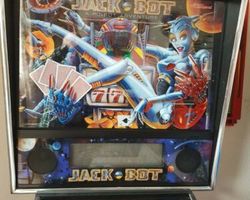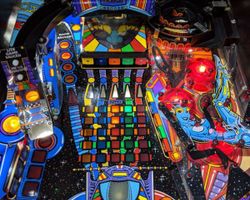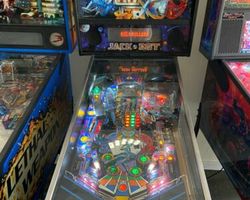Jack*Bot
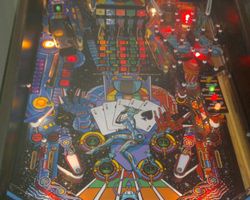
Average Prices: USD $800 to $2,200
Produced: October, 1995
Production Run: 2,428 units
Machine Type: Solid State Electronic
MPU: Williams WPC Security (WPC-S)
Players: 4
Design by: Larry DeMar, Barry Oursler
Art by: John Youssi, Doug Watson
Dots/Animation by: Adam Rhine, Brian Morris
Mechanics by: Robert C. Friesl, Bob Brown
Music by: Jon Hey
Sound by: Jon Hey
Software by: Larry DeMar, Louis Koziarz
Jack*Bot, released by Williams in October 1995, materialized as the third installment in a distinctive robotic pinball series that began with 1986's Pin*Bot and continued with 1991's The Machine: Bride of Pin*Bot. This lineage established a thematic connection, though Jack*Bot carved its own identity by blending the familiar robot aesthetic with a high-stakes casino theme. The machine was conceived during a dynamic period for pinball, leveraging Williams' WPC Security (WPC-S) system, a robust platform that enabled complex rules and elaborate features.
The creation of Jack*Bot involved a collaborative design effort. Barry Oursler and Larry DeMar shaped the game's overall design and playfield layout, building upon the foundations of its predecessors while introducing new mechanics. The artistic vision was brought to life by a team including Doug Watson, Greg Freres, John Youssi, and Paul Barker, with Doug Watson primarily handling the playfield art and John Youssi contributing to the backglass and cabinet. Notably, John Youssi indicated that the initial conceptualization phase saw Python Anghelo involved before John and Doug finalized the artwork. On the auditory front, Jon Hey composed the music and sound effects, complemented by custom callouts from Dave Zabriskie. Louis Koziarz was responsible for the software, ensuring the intricate ruleset functioned seamlessly, while Adam Rhine and Brian Morris crafted the animations. Mechanical engineering was overseen by Bob Brown and Robert C. Friesl. Produced with a run of 2,428 units, Jack*Bot entered the market with the marketing slogans "It's Within Everyone's Reach" and "A Sure Bet!", highlighting its accessible yet rewarding gameplay. An interesting piece of trivia reveals that "Lucky Star" was briefly considered as the machine's title, underscoring the early emphasis on the gambling motif. Throughout its production, some variations occurred, including two distinct playfield versions concerning the color of five arrow inserts below the 5-bank targets, and two designs for the plastic above the left ramp entrance. Additionally, the cabinet artwork appeared in two color schemes: "Red and Gold" and "Gold and Yellow," which were distinct variations rather than sun-faded examples.
Signature Features and Design
Jack*Bot’s design is characterized by several standout elements that directly contribute to its gameplay experience and thematic integration. The most prominent, and a direct nod to its heritage, is the robotic Visor. This bank of five touch targets on the playfield functions as a primary objective, eventually dropping to reveal the two "Eyes"—ball locks that are central to initiating multiball. The Keno Lights, a 5x5 grid, are illuminated by hitting Visor and Row Targets, tracking player progress toward opening the Visor and earning Keno Awards.
Another unique feature is the upper-level bagatelle mini-playfield, a distinct section that adds verticality and an element of randomness to ball trajectories. This multi-leveled design introduces different shot angles and challenges players to adapt. The left-side ramp is mechanically raised, providing dynamic shot opportunities and leading to various awards or the Solar Jets.
The "cheating" feature embedded within the casino games is a particular highlight. For instance, in the Slot Machine game, an initial spin might yield a poor result, but by pressing the extra ball button, the player can prompt Jack*Bot to "slam" the reels, often upgrading the award to an extra ball. Similarly, in "Roll the Dice," the player can cheat to guarantee a 12, and in "Pinbot Poker," an extra ace can be pulled. These mechanics cleverly reinforce the gambling theme by allowing players to subvert the odds, creating moments of amusement and strategic risk. The conical ramp used for the opening skill shot provides a distinct launch experience, sending the ball upwards into the Vortex, a spiral path with three holes that progressively enhance skill shot values and bonus multipliers.
Playfield and Mechanics
The Jack*Bot playfield is a vibrant canvas that skillfully blends mechanical complexity with a visually rich casino and robotic aesthetic. The layout, while drawing inspiration from Pin*Bot, offers its own distinct flow and shot opportunities. Central to the lower playfield are the standard two flippers, flanked by three pop bumpers located at the top right, referred to as the Solar Jets.
Major shots include the "Hit Me" target above the right inlane/outlane, which serves as a blackjack hand accumulator, awarding points based on the hand's value and lighting Jack*bots during Multiball. A three-bank of drop targets known as the "Poker Targets" are positioned to advance the bonus multiplier and spot poker cards, essential for completing hands. Underneath the ramp entrance lies the "Cashier Target," crucial for bonus collection, doubling game awards, and relighting the "Game Saucer."
The main upper-left ramp leads to the Solar Jets, the plunger lane for skill shots, or a return lane that offers various awards like extra balls or the "Mega Ramp" award. The "Game Saucer," located in the upper-left, is pivotal for initiating games, relighting Jack*bots, and spinning wheels during the "Casino Run." The "Visor," a bank of five touch targets, dominates the upper-center playfield. Behind it lie the "Eyes," two ball locks critical for starting multiball. Below and to the right of the Visor, another bank of five targets, the "Row Targets," work in conjunction with the Visor targets to light the 5x5 "Keno Lights" grid. The "Vortex," a spiral with three holes near the top, is directly fed by the skill shot and offers progressive awards, leading into the "Solar Jets" pop bumpers, which in turn build the "Roll the Dice" wager and points during "Solar Jets" mode.
The playfield artwork, predominantly by Doug Watson, features a vivid array of lights tracking target progress, enhancing player feedback and engagement. The integration of robotic and card game imagery is cohesive, contributing to an inviting and thematic playing environment. The diamond-plated playfield ensures fast and fluid ball movement, which is essential for the game's high-energy gameplay.
Gameplay Dynamics
Jack*Bot's gameplay dynamics revolve around two primary objectives: achieving multiball and completing the Casino Run, both offering distinct paths to high scores. The game introduces a manual plunger, initiating each ball with a skill shot into the Vortex, which can increase values and bonus multipliers.
Multiball is initiated by filling the Keno card, a 5x5 grid where lights are illuminated by hitting Visor targets (lighting entire columns) and Row Targets (lighting entire rows). Once the Keno card is completed, the Visor opens, revealing the "Eyes." Locking two balls in these eyes triggers the 3-ball multiball. During multiball, "Jack*bots" are lit at the Eyes, Cashier target, and Hit Me target, with their values progressively increasing. A "Super Jack*bot" is awarded for hitting an Eye, then quickly hitting the other. Sustained multiball play, accumulating 15 Jack*bots and then refilling the Keno card, can lead to the "Mega Visor" award, offering substantial points.
The "Casino Run" mode is the game's other major scoring avenue. It is accessed by playing all four unique Casino games. Once activated by shooting the Game Saucer, the Casino Run becomes a 45-second, one-ball timed mode where players collect points from switch hits and spin wheels by shooting the Eyes and Game Saucer. The core of Casino Run is a risk-reward mechanic: players can either collect their accumulated bank or risk it for another spin, aiming for higher awards or longer time. Making a skill shot during Casino Run adds extra time, and achieving "Casino Run Champion" status awards an extra credit.
The four Casino games—Pinbot Poker, Slot Machine, Roll the Dice, and Keno—each offer a unique mini-game experience. "Pinbot Poker" involves collecting poker cards from Poker targets and Keno awards, with points awarded for various poker hands, alongside a "cheat" option where Pinbot pulls an extra Ace. The "Slot Machine" spins reels for prizes like multiball or extra balls, featuring a "cheat" that can upgrade a poor award to an extra ball. "Roll the Dice" involves a wager that increases with Solar Jet hits, then two dice are rolled for multiplied points, with a "cheat" to force a 12. "Keno" picks random squares, awarding points for matching lit squares, and has a "cheat" that floods the card for a large score. These distinct modes, combined with strategic "cheating," provide varied gameplay and decision-making for players. Extra balls are awarded through various means, including completing poker hands, filling the Keno grid, slot machine wins, Casino Run awards, or through a "Pity Extra Ball" for low scores on the third ball.
Reception and Legacy
Jack*Bot has garnered a largely positive reception within the pinball community, often considered an underrated machine, especially when evaluated against its more prominent predecessor, Pin*Bot. Its strengths are frequently cited as a straightforward yet deep ruleset that keeps players engaged without being overly complex. The "Casino Run" mode stands out as a particular highlight, praised for its exciting risk-reward mechanics that create memorable gameplay moments. The multiball modes, including the dynamic "Mega Visor," are consistently enjoyed, and the overall integration of the gambling theme, complete with "double or nothing" choices and unique "cheating" features, adds an addictive and distinctive layer to the experience. Players appreciate the balance of challenging shots and the rewarding nature of the gameplay, contributing to its reputation as a fun, fast-paced game with significant replayability. The artwork, particularly the cabinet art, generally receives commendation, and the diamond-plated playfield is noted for contributing to the game's speed. The sound effects and music are often considered effective in enhancing the thematic atmosphere. The layout, recognized as a successful adaptation of the Pin*Bot playfield, and the overall build quality mean many owners consider Jack*Bot a worthwhile machine to include in a collection.
However, Jack*Bot is not without its criticisms. Some players find the gameplay can become repetitive over time, or that the experience may grow stale for some. While the artwork is generally well-received, a segment of the community views it as average or less visually striking compared to other machines of its era. The music, while functional, is not universally loved, with some describing it as cheesy or repetitive. From a playfield design perspective, the left flipper is occasionally perceived as underutilized, and the outlanes can be particularly brutal, leading to quick drains. The "Casino Run" mode, while a highlight, can also be a source of frustration for some players due to its reliance on chance and perceived complexity. Similarly, some find the overall ruleset, particularly when diving into the nuances of each casino game, to be overly complicated or, for a select few, boring.
Despite these minor criticisms, the overall sentiment towards Jack*Bot remains positive. It is widely regarded as a challenging, addictive, and enjoyable game, especially for those who appreciate its unique gambling theme. Its legacy lies in its ability to take a proven robotic concept and infuse it with a fresh, interactive casino mechanic, demonstrating Williams' capacity for innovation within established series. While it may not command the same initial recognition as some other titles from its prolific manufacturer, Jack*Bot continues to hold a respected place among enthusiasts as a solid and often underestimated machine that provides a rewarding and engaging pinball experience.
Sponsored Links
 Ebay Listings
Ebay Listings
 Auction Results
Auction Results
| Cost | Location | Date |
|---|---|---|
| USD $4,000 |  Minnesota, United States Minnesota, United States |
03 June, 2025 |
| USD $4,300 |  Minnesota, United States Minnesota, United States |
14 December, 2023 |
| USD $4,800 |  New York, United States New York, United States |
07 December, 2023 |
| USD $2,900 |  Virginia, United States Virginia, United States |
03 June, 2023 |
| GBP £2,995 |  Lytham, United Kingdom Lytham, United Kingdom |
25 December, 2021 |
| USD $3,675 |  Indiana, United States Indiana, United States |
21 December, 2020 |
| USD $3,200 |  New York, United States New York, United States |
20 November, 2020 |
| GBP £2,200 |  Coventry, United Kingdom Coventry, United Kingdom |
19 September, 2020 |
| USD $4,995 |  Michigan, United States Michigan, United States |
03 September, 2020 |
| USD $4,000 |  New York, United States New York, United States |
25 August, 2020 |


Private Policy · Search Website · Contact Us
As an eBay Partner, we may earn a commission from qualifying purchases made through links on this site, at no additional cost to you.
All trademarks and copyrighted materials remain property of their respective owners. All other content copyright 2007 - 2025 Pinpedia.

